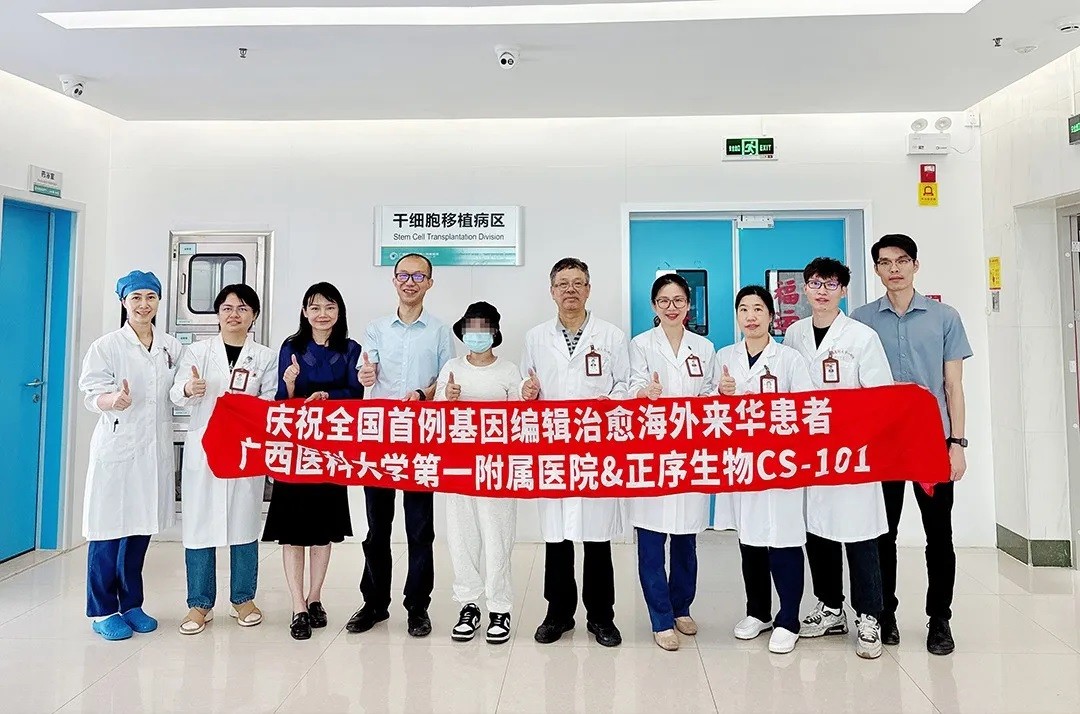
On July 20, CorrectSequence Therapeutics (Correctseq), a ShanghaiTech-incubated company specializing in gene editing theray, announced a significant milestone in their base editing therapy CS-101 for transfusion-dependent β-thalassemia. Utilizing their pioneering transformer Base Editor (tBE), Correctseq has successfully cured the first overseas patient from Laos with transfusion-dependent β-thalassemia in a clinical trial conducted in collaboration with the First Affiliated Hospital of Guangxi Medical University. The patient was diagnosed with transfusion-dependent β-thalassemia and required 2 units of red blood cells (RBC) per month prior to receiving CS-101 treatment. Following the therapy, the patient’s hemoglobin level has reached at above 120 g/L within two months and maintained at such level as of the report date. As a result, the patient has been able to resume a normal life.

This milestone marks China’s first documented report of an overseas patient being clinically cured through gene editing therapy. As of the reporting date, the clinical trial for CS-101 has yielded remarkable results. Several patients with transfusion-dependent β-thalassemia who received CS-101 treatment have all achieved transfusion independence. Notably, two patients have remained transfusion-free for over six months, with the longest duration exceeding eight months.Hemoglobinopathies encompass the most prevalent group of monogenic diseases globally. Among them, β-thalassemia is particularly prevalent in southern China, as well as in Mediterranean countries, South Asian and Southeast Asian countries. In China alone, there are approximately 30 million individuals carrying the thalassemia mutant gene, with around 300,000 severe and intermediate thalassemia patients. In Southeast Asia, approximately 300 million people carry the thalassemia mutant gene, accounting for 44.60% of the total population in the region.CS-101, a pioneering cell and gene therapy based on tBE, holds the promise of a “single treatment, lifetime cure” for patients with β-hemoglobinopathies worldwide. This groundbreaking advancement brings hope for a complete cure to those enduring these health challenges.
The successful implementation of the CS-101 clinical trial is a testament to the safety of the base editing technology employed and the selection of effective targets. The underlying principle of CS-101 involves the collection of the patient’s own hematopoietic stem cells, followed by the utilization of tBE. Pioneered by scientists at ShanghaiTech University, this technology enables the precise editing of the DNA sequence within the promoter region of the gene responsible for encoding γ-globin (HBG1/2).
By mimicking a naturally occurring beneficial single-nucleotide variant found in individuals with hereditary persistence of fetal hemoglobin, the tBE reactivates γ-globin expression, resulting in the production of functional HbF. The edited stem cells are then reintroduced into the patient’s body, enabling continuous production of blood cells with functional hemoglobin. This approach eliminates the need for frequent blood transfusions, offering a significant advancement in the treatment of transfusion-dependent β-thalassemia.
Compared to traditional blood transfusion therapy and allogeneic hematopoietic stem cell transplantation, CS-101 offers several compelling advantages. One of the key benefits is its short preparation period. Another is eliminating the need for long waiting time for a matching donor since it utilizes the patient’s own hematopoietic stem cells. In comparison to other CRISPR-based β-thalassemia gene editing therapies, CS-101 does not carry safety risks associated with large DNA fragment deletions, chromosomal translocation, or off-target mutations. This enhances the overall safety profile of the treatment and reduces potential complications.
Overall, CS-101 offers a promising approach for the treatment of transfusion-dependent β-thalassemia, providing faster and safer hematopoietic reconstruction, quicker restoration of hemoglobin levels, and a shorter path to achieving transfusion independence compared to other therapies.
Correctseq is dedicated to expediting the clinical translation of pioneering gene editing technologies. By developing best-in-class gene editing therapy and first-in-class base editing therapy, Correctseq aims to provide safe, reliable, and cost-effective treatment options for patients worldwide.